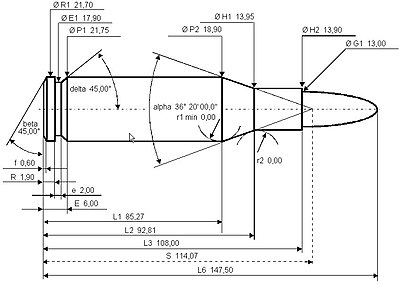| 12.7×108 mm | ||||||||||||
|---|---|---|---|---|---|---|---|---|---|---|---|---|
 A 12.7×108mm cartridge | ||||||||||||
| Type | Heavy machine gun | |||||||||||
| Place of origin | Soviet Union | |||||||||||
| Service history | ||||||||||||
| Used by | Soviet Union and successor states | |||||||||||
| Wars | Winter War, World War II, Korean War, Portuguese Colonial War, Vietnam War, Cambodian Civil War, Cambodian–Vietnamese War, Six-Day War, War of Attrition, Yom Kippur War, Soviet war in Afghanistan, Iran–Iraq War, Gulf War, Chechen War, Iraq War, War in Afghanistan, Libyan civil war, Syrian civil war, many others | |||||||||||
| Specifications | ||||||||||||
| Bullet diameter | 12.98 mm (0.511 in) | |||||||||||
| Neck diameter | 13.95 mm (0.549 in) | |||||||||||
| Shoulder diameter | 18.90 mm (0.744 in) | |||||||||||
| Base diameter | 21.75 mm (0.856 in) | |||||||||||
| Rim diameter | 21.70 mm (0.854 in) | |||||||||||
| Rim thickness | 1.90 mm (0.075 in) | |||||||||||
| Case length | 108 mm (4.3 in) | |||||||||||
| Overall length | 147.50 mm (5.807 in) | |||||||||||
| Case capacity | 22.72 cm3 (350.6 gr H2O) | |||||||||||
| Maximum pressure | 360 MPa (52,000 psi) | |||||||||||
Ballistic performance
| ||||||||||||
| Source(s): world.guns.ru | ||||||||||||
The 12.7×108 mm cartridge is a heavy machine gun and anti-materiel rifle cartridge used by the former Soviet Union, the former Warsaw Pact, modern Russia, and other countries.
It is used in the same roles as the NATO .50 BMG (12.7×99mm NATO) cartridge. The two differ in bullet shape and weight, and the casing of the 12.7x108mm is slightly longer and thicker, allowing it to hold slightly more of a different type of powder. The 12.7x108mm can be used to engage a wide variety of targets on the battlefield, and will destroy unarmored vehicles, penetrate lightly armored vehicles and damage external ancillary equipment (i.e.: searchlights, radar, transmitters, vision blocks, engine compartment covers) on heavily armored vehicles such as tanks.[1] Armor piercing .50 cal ammunition will penetrate around 25 mm of armor. Normal full metal jacket .50 cal ammunition will only dimple tank armor, causing no damage.
In the Finnish Defence Forces, the NSV chambered in 12.7×108 is used primarily in an anti-aircraft role by all branches.[2]
Cartridge dimensions[]
The 12.7×108mm has 22.72 ml (350 grains) H2O cartridge case capacity.
12.7×108 maximum cartridge dimensions. All sizes in millimetres (mm).
Americans would define the shoulder angle at alpha/2 ≈ 18.16 degrees.
According to guidelines the 12.7×108mm case can handle up to 360 MPa (52,213 psi) piezo pressure. In C.I.P. regulated countries every rifle cartridge combo has to be proofed at 125% of this maximum CIP pressure to certify for sale to consumers.
Incorrect interchangeability claims[]
It is often claimed that the US .50 BMG (12.7×99mm NATO) cartridge can be fired in Soviet/Russian 12.7×108mm machine guns. The 12.7×108mm was even called a “.51-caliber.” This often claimed interchangeability is an assumption made from the 12.7×108mm being listed as “.511-caliber” in US intelligence publications during the Vietnam War. The bullets used for both cartridges are ~.51 inches in diameter. .50 caliber, 1/2 of an inch, is the diameter of the hole bored down the barrel of the gun first. Then rifling is cut all around the bored hole to a depth of .005". Thus, .500 + .005 + .005 = .510." Upon firing the bullet engages the rifling, and .005" grooves are pressed into the surface of the bullet to impart spin to stabilize the bullet. Despite the similar bullet diameters, the dimensional differences between the two cartridges would prevent either being correctly chambered in a firearm designed for the other.
Firearms using this cartridge[]
- AMR-2 anti-materiel sniper rifle
- DShK heavy machine gun
- Berezin UB aircraft machine gun
- NSV heavy machine gun
- Kord heavy machine gun
- Type 77 Heavy Machine Gun
- W85 Heavy Machine Gun
- ČZW-127 anti-materiel sniper rifle
- V-94 anti-tank/anti-materiel rifle
- KSVK anti-materiel sniper rifle
- Gepard anti-materiel rifles
- M93 sniper rifle
- Vidhwansak Anti-Material Rifle
- 6P62 anti-material assault rifle
- OSV-96 anti-material sniper rifle
- Zastava M02 Coyote heavy machine gun
- Yak-B 12.7mm Gatling gun
- SVN-98 experimental anti-material rifle
- Zastava M87 heavy machine gun
- Yu-12.7 aircraft gun
See also[]
References[]
- Koll, Christian (2009). Soviet Cannon - A Comprehensive Study of Soviet Arms and Ammunition in Calibres 12.7mm to 57mm. Austria: Koll. p. 72. ISBN 978-3-200-01445-9. http://www.russianammo.org.
Further reading[]
- Борцов А.Ю. "Пятилинейный", Мастер-ружье issue 110, May 2006, pp. 56–62
External links[]
·
The original article can be found at 12.7×108mm and the edit history here.
